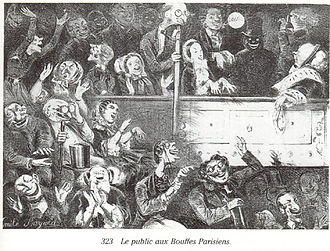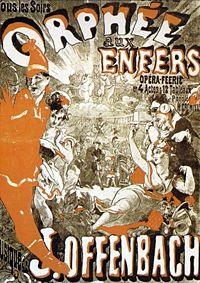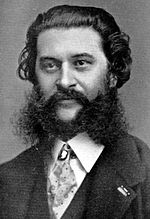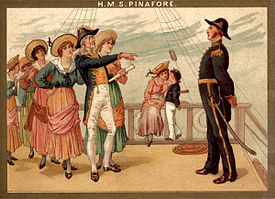- Operetta
-
Operetta is a genre of light opera, light in terms both of music and subject matter. It is also closely related, in English-language works, to forms of musical theatre.
Contents
Operetta in French
Origins
Operetta grew out of the French opéra comique around the middle of the 19th century, to satisfy a need for short, light works in contrast to the full-length entertainment of the increasingly serious opéra comique. By this time, the "comique" part of the genre name had become misleading: Carmen (1875) is an example of an opéra comique with a tragic plot. The definition of "comique" meant something closer to "humanistic," meant to portray "real life" in a more realistic way, representing tragedy and comedy next to each other, as Shakespeare had done centuries earlier. With this new connotation, Opéra comique had dominated the French operatic stage since the decline of tragédie lyrique.
Most researchers acknowledge that the credit for creating the operetta form should go to Hervé (1825–1892), a singer, composer, librettist, conductor, and scene painter.[1] In 1842 he wrote the little opérette, L'Ours et le pacha, based on the popular vaudeville show by Scribe and Saintine. In 1848, Hervé made his first notable appearance on the Parisian stage, with Don Quichotte et Sancho Pança, which can be considered the starting point for the new French musical theatre tradition. Hervé's most famous works are the Gounod-parody Le Petit Faust (1869) and Mam'zelle Nitouche (1883).
Offenbach
Jacques Offenbach further developed and popularized operetta, giving it its enormous vogue during the Second Empire and afterwards.[2] Offenbach's earliest one-act pieces included Les deux aveugles, Le violoneux and Ba-ta-clan (all 1855), and his first full-length operetta success was Orphée aux enfers (1858). These led to the so-called "Offenbachiade": works including Geneviève de Brabant 1859, Le pont des soupirs 1861, La belle Hélène 1864, Barbe-bleue and La Vie parisienne both 1866, La Grande-Duchesse de Gérolstein 1867, La Périchole 1868 and Les brigands 1869. Offenbach's tradition was then carried on by Robert Planquette, André Messager, and others.
What characterizes Offenbach's operettas is both the grotesque way they portray life, and the extremely frivolous way this is done, often bordering on the pornographic. Émile Zola describes the back-stage and on-stage situation in the Théâtre des Variétés during the Second Empire in his novel Nana, which takes place in late 1860s and describes the career of operetta diva/courtesan Nana. The character was closely modeled after Offenbach's female star Hortense Schneider, and Offenbach's librettist Ludovic Halévy gave Émile Zola the details. Considering how Zola's Nana describes an Offenbach-style operetta performance in Paris, it is not surprising that the mostly male, upper-class audience crowded the various theaters every evening. Upper-class audiences in other cities like Vienna and Berlin longed to see these shows in their home towns as well, which inspired worldwide performance of Offenbach's works.
The highly erotic way Offenbach's operettas were originally played, with stars like Hortense Schneider — or the legendary courtesan Cora Pearl, who appeared in a revival of Offenbach's Orphée aux Enfers in 1867 completely covered in diamonds and little else — created a scandalized reaction from certain parts of the general public. Operetta was considered a "frivolous" art form. Indeed, together with its grotesque qualities, frivolity is one of the defining elements of "authentic" operetta à la Offenbach and Hervé.
It was only later, when audiences widened and became more middle and lower class, that operetta became more "serious" and "nostalgic". Many of the originally pornographic French (and Viennese) operettas were later played in a toned-down, "classical" version, which is how audiences today are mostly presented with the genre — in an opera house with opera singers, rather than in a private theatre with courtesans in the lead roles.[3]
Operetta in German
Austria
The most significant composer of operetta in the German language was the Austrian Johann Strauss, Jr. (1825–1899). His first operetta was Indigo und die vierzig Räuber (1871). His third operetta, Die Fledermaus (1874), became the most performed operetta in the world, and remains his most popular stage work. Its libretto was based on a comedy written by Offenbach's librettists.[4] In all, Strauss wrote 16 operettas and one opera, most with great success when first premiered. Many of his lesser operettas are now largely forgotten, since his later librettists were less talented and he often composed independently of the plot.
Strauss's operettas, waltzes, polkas, and marches often have a strongly Viennese style, and his popularity causes many to think of him as the national composer of Austria. In fact, when his stage works were first performed, the Theater an der Wien never failed to draw huge crowds, and after many of the numbers the audience would call noisily for encores.
Franz von Suppé, a contemporary of Strauss, closely modeled his operettas after Offenbach. The Viennese tradition was carried on by Franz Lehár, Oscar Straus, Carl Zeller, Karl Millöcker, Leo Fall, Richard Heuberger, Edmund Eysler, Ralph Benatzky, Robert Stolz, Emmerich Kálmán and Nico Dostal in the 20th century.
Germany
In the same way that Vienna was the center of Austrian operetta, Berlin was the center of German operetta. Berlin operetta often had its own style, including, especially after World War I, elements of jazz and other syncopated dance rhythms, a transatlantic style, and the presence of ragged marching tunes. Berlin operettas also sometimes included aspects of burlesque, revue, farce, or cabaret.
 Paul Lincke, father of the Berlin operetta
Paul Lincke, father of the Berlin operetta
Paul Lincke pioneered the Berlin operetta in 1899 with Frau Luna, which includes "Berliner Luft" ("Berlin Air"),[5] which became the unofficial anthem of Berlin. His Lysistrata (1902) includes the song and tune "The Glow-Worm", which remains quite popular internationally. Much later, in the 1920s and 1930s, Kurt Weill took a more extreme form of the Berlin operetta style and used it in his operas, operettas, and musicals.
The Berlin-style operetta coexisted with more bourgeois, charming, home-loving, and nationalistic German operettas — some of which were called Volksoperetten (folk operettas). A prime example is Leon Jessel's extremely popular 1917 Schwarzwaldmädel (Black Forest Girl).[6] These bucolic, nostalgic, home-loving operettas were officially preferred over Berlin-style operettas after 1933, when the Nazis came to power and instituted the Reichsmusikkammer (State Music Institute), which deprecated and banned "decadent" music like jazz and similar "foreign" musical forms.
Notable German operetta composers include Paul Lincke, Eduard Künneke, Walter Kollo, Jean Gilbert, Leon Jessel, Rudolf Dellinger, and Walter Goetze.
Operetta in English
English-language operettas were first composed in England in the 1860s — for example, Sullivan's Cox and Box (1866). They were soon known as comic operas, to distinguish this family-friendly fare from the risqué French operettas of the 1850s and 1860s.
The height of the form was reached by Gilbert and Sullivan, who had a long-running collaboration during the Victorian era. With W. S. Gilbert writing the libretti and Arthur Sullivan composing the music, the pair produced 14 comic operas, sometimes called Savoy Operas. Most were enormously popular in Britain, the U.S., and elsewhere. Their works, such as H.M.S. Pinafore, The Pirates of Penzance, and The Mikado, continue to enjoy regular performances throughout the English-speaking world.[7]
English operetta continued into the 20th century, with works by composers such as Edward German, Lionel Monckton, and Harold Fraser-Simson. Increasingly, these took on features of musical comedy, until the distinction between an "old-fashioned musical" and a "modern operetta" became blurred. Old-fashioned musicals in Britain, in particular, retained an "operetta-ish" flavour into the 1950s.
American operetta composers included Victor Herbert, whose works at the beginning of the 20th century were influenced by both Viennese operetta and Gilbert and Sullivan.[8] He was followed by Sigmund Romberg and Rudolph Friml. More modern American operettas include Leonard Bernstein's Candide. Nevertheless, by 1930, English-language operetta had largely given way to musicals, such as Show Boat, Oklahoma!, etc.
Definitions
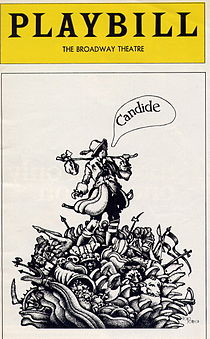 Candide has been performed as a Broadway musical, and as an operetta at New York City Opera and elsewhere.
Candide has been performed as a Broadway musical, and as an operetta at New York City Opera and elsewhere.
Operettas have similarities to both operas and musicals, and the boundaries between the genres are sometimes blurred. For instance, American composer Scott Joplin insisted that his serious but ragtime-influenced work Treemonisha (1911) was an opera, but some reference works characterize it as an operetta. Likewise, some of Leonard Bernstein's works he designated as operas (e.g., Trouble in Tahiti) are categorized as operettas, and his operetta Candide is sometimes considered a musical.
Operettas and operas
Operettas are usually shorter than operas, and are usually of a light and amusing character. Operettas are often considered less "serious" than operas.
Topical satire is a feature common to many operettas. However, satire is used in some "serious" operas as well: Formerly, in countries such as France, operas expressed politics in code — for example, the circumstances of the title character in the opera Robert le diable referred, at its first performance, to the French king's parental conflict and its resolution.
Normally some of the libretto of an operetta is spoken rather than sung. Instead of moving from one musical number to another, the musical segments — e.g. aria, recitative, chorus — are interspersed with periods of dialogue. There is usually no musical accompaniment to the dialogue, although sometimes some musical themes are played quietly under it. Short passages of recitative are, however, sometimes used in operetta, especially as an introduction to a song.
Operettas and musicals
The operetta is a precursor of the modern musical theatre or "musical".[9] In the early decades of the 20th century, the operetta continued to exist alongside the newer musical, with each influencing the other.
The main difference between the two genres is that most operettas can be described as light operas with acting, whereas most musicals are plays with singing. This can be seen in the performers chosen in the two forms. An operetta's cast will normally be classically-trained opera singers. A musical uses actors who sing, but usually not in an operatic style. These distinctions can be blurred: W.S. Gilbert, for example, said that he preferred to use actors who could sing for his productions, while Ezio Pinza, and other opera singers have appeared on Broadway. There are features of operetta in Kern and Hammerstein's Show Boat (1927), among others.[10]
The characters in a musical may be more complex than those in an operetta, given the generally larger amount of dialogue. For example, the characters in Lerner and Loewe's musical My Fair Lady, which is based on George Bernard Shaw's 1914 play Pygmalion, are essentially unchanged from those in Shaw's stage work, because the musical version is quite faithful to the original (except for the changed ending, which is pessimistic in the play), even to the point of retaining most of Shaw's dialogue. Man of la Mancha, adapted by Dale Wasserman from his own ninety-minute television play I, Don Quixote, retains much of the dialogue in that play, cutting only enough to make room for the musical numbers which were added when the play was converted into a stage musical.
See also
- List of operetta composers
- The opera corpus which includes operettas
- Opera
- Zarzuela
- Comic opera
- Savoy opera
- Musical theatre
Notes
- ^ Lubbock, Mark. "The Music of 'Musicals'". The Musical Times, Vol. 98, No. 1375 (September, 1957), pp. 483–85, Musical Times Publications Ltd., accessed 17 August 2010
- ^ Ernest Newman, in Louis Biacolli, ed. The Opera Reader (New York: McGraw-Hill) 1953:317.
- ^ Marion Linhardt describes the change in audiences and repertoire with regard to Vienna in her book Residenzstadt und Metropole. Zu einer kulturellen Topographie des Wiener Unterhaltungstheaters (1858–1918), whereas the erotic element of operetta has been described in the first (German language) gender study on operetta, Kevin Clarke's Glitter and be Gay: Die authentische Operette und ihre schwulen Verehrer (2007).
- ^ In fact, Strauss may have been convinced to write the operetta by Offenbach himself although it is now suggested that it may have been his first wife, Henrietta Treffz who repeatedly encouraged Strauss to try his hand at writing for the theater.
- ^ "Berliner Luft" conducted by Placido Domingo with the Berlin Philharmonic
- ^ Lamb, Andrew. 150 Years of Popular Musical Theatre. Yale University Press, 2001. p. 203.
- ^ See Bradley, Ian (2005). Oh Joy! Oh Rapture! The Enduring Phenomenon of Gilbert and Sullivan. Oxford University Press. ISBN 0195167007. and Hewett, Ivan. "The Magic of Gilbert and Sullivan". The Telegraph, 2 August 2009. Retrieved 14 April 2010.
- ^ Ledbetter, Steven. "Victor Herbert", Grove Music Online ed. L. Macy, accessed February 11, 2009 (subscription required)
- ^ Jones, J. Bush. Our Musicals, Ourselves, pp. 10–11, 2003, Brandeis University Press: Lebanon, N.H. (2003) 1584653116
- ^ Bordman, Gerald. "Jerome David Kern: Innovator/Traditionalist", The Musical Quarterly, 1985, Vol. 71, No. 4, pp. 468–73
References
- Ganzl, Kurt. The Encyclopedia of Musical Theatre (3 Volumes). New York: Schirmer Books, 2001.
- Traubner, Richard. Operetta: A Theatrical History. Garden City, NY: Doubleday & Company, 1983
- Bordman, Gerald. American Operetta. New York: Oxford University Press, 1981.
- Linhardt, Marion, Residenzstadt und Metropole. Zu einer kulturellen Topographie des Wiener Unterhaltungstheaters (1858–1918). Berlin: Max Niemeyer Verlag, 2006 (German)
- Clarke, Kevin, Glitter and be Gay: Die authentische Operette und ihre schwulen Verehrer. Hamburg: Männerschwarm Verlag, 2007 (German)
- Riccardo Viagrande, Tu che m'hai preso il cuor. Un viaggio nel mondo dell'operetta, Casa Musicale Eco, Monza, 2009 (Italian)
External links
- Extensive site with information about operettas, light operas and their composers
- Essay on operettas of Offenbach, Johann Strauss Jr. and their contemporaries
- Operetta Research Center (with a large archive of historical reviews)
- Seite zu französischen Operetten-Einaktern (dzt. im Aufbau befindlich)
Opera genres Acte de ballet · Afterpiece · Azione sacra · Azione teatrale · Ballad opera · Ballet héroïque · Bühnenfestspiel · Bühnenweihfestspiel · Burletta · Comédie en vaudeville · Comédie lyrique · Comédie mêlée d'ariettes · Drame lyrique · Dramma eroicomico · Dramma giocoso · Dramma pastorale · Dramma per musica · Fait historique · Farsa · Festa teatrale · Género chico · Género grande · Gesamtkunstwerk · Grand Opera · Handlung · Intermède · Intermezzo · Liederspiel · Märchenoper · Melodramma · Musikdrama · Opéra · Opera ballo · Opéra-ballet · Opera buffa · Opéra bouffe · Opéra bouffon · Opéra comique · Opéra féerie · Opéra lyrique · Opera semiseria · Opera seria · Operetta · Operette · Opérette · Pasticcio · Pastorale héroïque · Posse mit Gesang · Romantische Oper · Sainete · Savoy opera · Saynète · Schauspiel mit Gesang · Schuloper · Semi-opera · Sepolcro · Serenata · Singspiel · Songspiel · Spieloper · Syngespil · Tonadilla · Tragédie en musique · Verismo · Zarzuela · Zauberoper · Zeitoper · ZwischenspielCategories:- Opera genres
- Opera terminology
- Italian loanwords
Wikimedia Foundation. 2010.

